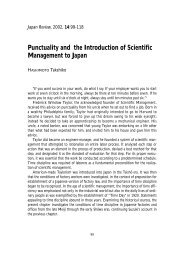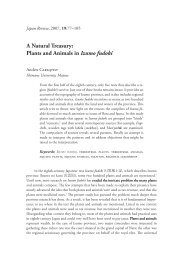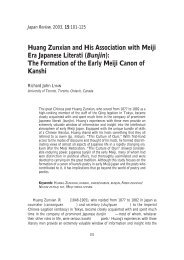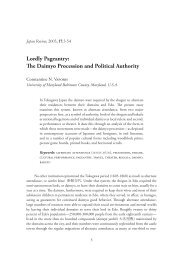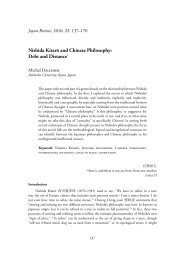Meiji shinkyoku - 国際日本文化研究センター
Meiji shinkyoku - 国際日本文化研究センター
Meiji shinkyoku - 国際日本文化研究センター
You also want an ePaper? Increase the reach of your titles
YUMPU automatically turns print PDFs into web optimized ePapers that Google loves.
<strong>Meiji</strong> <strong>shinkyoku</strong>: Th e Beginnings of Modern Music for the Koto<br />
Music that was to support Japanese melodies without making them sound Western. Japanese<br />
music would then match and compete with Western music in its complexity and sophistication,<br />
but nevertheless remain unmistakably Japanese. Th is required the expansion of the ranges<br />
available on the koto, and in 1921, the year in which Miyagi composed this work, he developed<br />
the seventeen-stringed bass koto. 45 Triads similar to the D minor opening gesture exchanged<br />
between the bass koto and the shamisen appear throughout the piece, and over it the koto’s<br />
melodic line is placed. Th is is interspersed with sections in which the three instruments interact<br />
in a contrapuntal fashion as the bass koto and the shamisen execute independent melodies.<br />
Despite having a clear melody, the function of the bass koto, however, remains to provide a<br />
sense of harmonic structure. A fi nal observation is that Ochiba no odori represents a complete<br />
break from indigenous models of composition, and is a rondo, one of several compositional<br />
forms Miyagi borrowed from Western music. 46<br />
Concluding Observations<br />
Placed between the early <strong>Meiji</strong> <strong>shinkyoku</strong> and Miyagi, Tateyama’s works and those of the<br />
other second phase composers are a doorway framed by a populist esthetic that opens from the<br />
past to the future. Like Janus, they stand transfi xed, enthralled with visions of the future yet<br />
unable to tear their gaze from the beauties of the past; they engage with both, yet belong to<br />
neither, as a now largely forgotten conduit of inestimable value between the two. Th e second<br />
phase works highlight the inherent strength of the early <strong>Meiji</strong> <strong>shinkyoku</strong>. Th e two attributes<br />
that have ensured their survival are 1) the adherence to pre modern styles of composition<br />
and 2) the texts, all of which avoid the open nationalism of the mid <strong>Meiji</strong> period, and allow<br />
for reinterpretation. In keeping the premodern compositional esthetic intact, the fi rst phase<br />
composers created works that still required the listener to engage with the musical object,<br />
to listen critically to the musical materials and the manner of their composition, and then<br />
pass judgement. Th ey nonetheless laid the foundations for the second period composers and<br />
Tateyama with their oblique reference to mishingaku and their endeavour to popularise the<br />
koto. Th is fundamental shift in æstehtics allowed Tateyama to turn openly to popular culture—<br />
the clear references to military music in Gaisen rappa no shirabe, for example, or the suggestions<br />
of harmony in Hototogisu no kyoku—which led to the creation of works that are in many ways<br />
overly transparent in their appeal to popular sentiment. Th e consumer is not placed in the<br />
position of having to engage critically with the music for it is manifest, the esthetic intensity<br />
of the earlier works lost. Tateyama’s works elicit an immediate emotional response, which in<br />
turn accounts for their mass appeal; they were indeed popular, and their temporal specifi city<br />
renders later reinterpretation problematic. In terms of Japanese music history, however, their<br />
importance is unquestionable.<br />
Th e texts for many of the <strong>Meiji</strong> <strong>shinkyoku</strong> that adhere to the esthetics of the fi rst phase,<br />
even those that can be understood as originating in nationalist sentiment, can be construed<br />
as suffi ciently vague, and the taint of nationalism faint enough to permit reinterpretation.<br />
Saga no aki, for example, takes its text from a chapter in the Tale of the Heike, Japan’s great<br />
military epic. Th e chapter in question, however, is one of the great romantic moments in the<br />
book, and recounts Nakakuni’s ability to locate Kogō no Tsubone 小督の局, who has secluded<br />
herself in the outskirts of Kyoto, by the sound of her koto. Takano Shigeru 高野茂 (1847–<br />
1929) composed Ōuchiyama 大内山 in 1892 for the celebration of the <strong>Meiji</strong> emperor’s silver<br />
wedding anniversary, unmistakably a work composed under the infl uence of nationalism., Th e<br />
117



